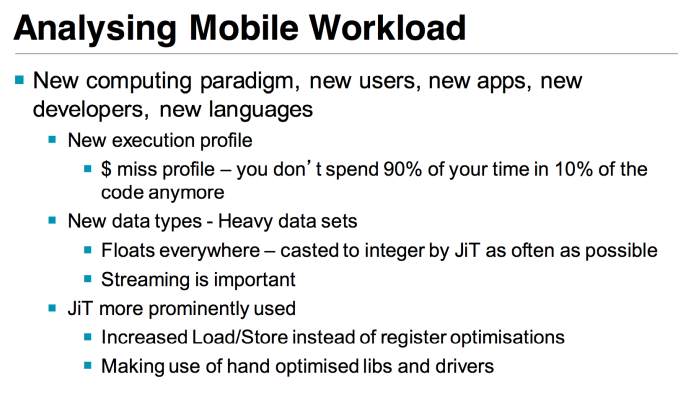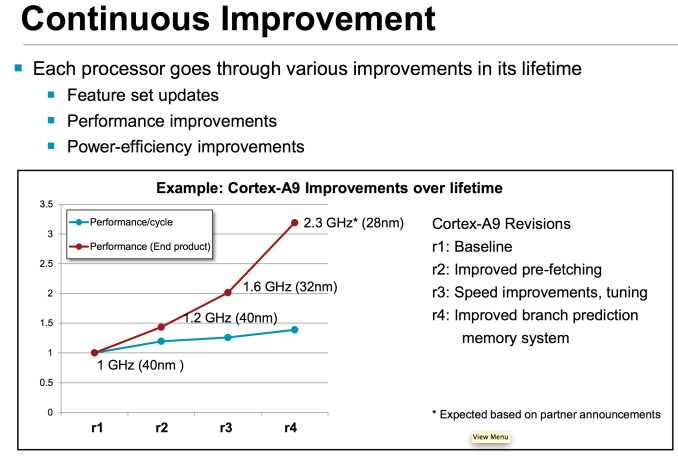The ARM Diaries, Part 2: Understanding the Cortex A12
by Anand Lal Shimpi on July 17, 2013 12:30 PM EST- Posted in
- CPUs
- Arm
- SoCs
- Cortex A12
Performance Expectations & Final Words
ARM’s Cortex A9 was first released to licensees back in 2009, with design work beginning on the core years before that. To say that the smartphone market has changed tremendously over the past several years would be an understatement. Many of the assumptions that were true at the time of the Cortex A9’s development are no longer the case. There’s far more NEON/FP code in use on mobile platforms, higher frequency of memory accesses and much heavier performance demands in general. While the Cortex A9 was a good design for its time, its weaknesses on the FP and memory fronts needed addressing. Thankfully, Cortex A12 modernizes the segment.
Although ARM referred to Cortex A9 as an out-of-order design, in reality it supported out-of-order integer execution with in-order FP and memory operations. ARM’s Cortex A12 moves to an almost completely OoO design. All aspects of the design have been improved as well. Although the Cortex A9 is expected to continue to ramp in frequency over the next year as designs transition to 28nm HPM and beyond, Cortex A12 should deliver much better performance in an more energy efficient manner.
At the same frequency (looking just at IPC), ARM expects roughly a 40% uplift in performance over Cortex A9. The power efficiency and area implications are more interesting. ARM claims that on the same process node as a Cortex A9, a Cortex A12 design should be able to deliver the same or better power efficiency. The design achieves improved power efficiency by throwing more die area at the problem; ARM expects a Cortex A12 implementation to be up to 40% larger than a Cortex A9. Just like the increasing performance of the Cortex A15 line of microarchitectures necessitates development of the Cortex A9/A12 line, the increasing size of this line drives up demand for the Cortex A7/A53 family below it.
ARM’s unique business model allows for the extreme targeting and customization of its microprocessor IP portfolio. If one of its cores gets too large (or power hungry), there’s always a smaller/more energy efficient option downstream.
The Cortex A12 IP has been finalized as of a couple of weeks ago and is now available to licensees for integration. The first designs will likely ship in silicon in a bit over a year, with the first devices implementing Cortex A12 showing up in late 2014 or early 2015. Whether or not the design will be too late once it arrives is the biggest unknown. Qualcomm’s Krait 300 core should provide the smartphone market with an alternative solution, but the question is whether or not the mobile world will need a Cortex A12 when it shows up. We always like to say that there are no bad products, just bad pricing. A more aggressively priced alternative to a Snapdragon 600 class SoC may entice some customers. Until then, the latest revision to the Cortex A9 core (r4) is expected to carry the torch for ARM. ARM also tells us that we might see more power optimized implementations of Cortex A15 in the interim as well.












65 Comments
View All Comments
wumpus - Friday, July 19, 2013 - link
And I didn't see anyway for 32bit ARM to access more than 3G. Maybe there is, but the PAE-style mechanism that allowed each process to access 4G of ram (well 2-3G of user space and 2-1G of OS space). It looks like each process sees 32 bit MMU tags meaning no way to access the whole RAM. Again, somewhere in there they might have an unholy kludge, but I suspect that they are more than willing to do things the [PAE] intel way [not the 286 way that Microsoft forced everyone to support a decade after it was consigned to the junkyard].wumpus - Friday, July 19, 2013 - link
So how does one process access more than 4G (3G if Linux, likely less else where)? There is a reason nobody uses 32 bit chips. If you really looked up the datasheets, the *80386* chip could access way more than 64G virtual ram (it didn't have the pins for more than 4G of memory). You could even access it fairly easily in a process, but as far as I know *nobody* ever tried that.Note: Linux 0.x and I think 1.x could both handle 3G per memory process. Maybe not, I know Linus used the 386 segmentation scheme natively on different processes, but I have no idea if the 386 MMU could handle tags that depended on the segmentation scheme (it was quite possible you could either go wild with segments, or use them traditionally and have full MMU operation. I haven't looked at this stupid idea since 1990, when I learned the disaster that is x86.
We use 64 bit chips for a reason. If we didn't need to access memory the size of an integer register, I would strongly suspect that all integer registers would be 16 bits long (note the pentium4 computed integer operations 16 bits at a time, they are notably faster). Using a 64 bit register and 64 bit addressing means that you can access an entire database of arbitrary size (2^63, whatever that is), while using 32 bit machines requires a "networking" OS call to whichever process happens to have that particular datum in memory. It is yet another unholy kludge and the reason that "the only fatal mistake a computer architecture can have is too small a word size".
Wilco1 - Friday, July 19, 2013 - link
You don't need to access more than 3GB per process on a mobile! Mobiles/tablets will have 4GB of RAM, however each process still has it's own 32-bit address space and uses only a portion of the available RAM.There is no need to be so obsessed about 64-bit, you know the the Windows world is still mostly 32-bit 10 years after the introduction of Athlon64... Even Windows 8 still has a 32-bit version. So while there are lots of 64-bit chips around, most run only 32-bit code. My Athlon64 which I retired last year never ever ran 64-bit code during its entire life!
You only really require 64-bit addressing if you have big applications that need more than 3GB per process. Such applications are rare (your database is an example) and they only run on large expensive servers, not on mobiles. So clearly the need for 64-bit is extremely small, and mobiles/tablets will simply use PAE rather than switch to 64-bit for the foreseeable future.
Calinou__ - Saturday, July 20, 2013 - link
64 bit is still a technogy of the future. Not to mention PAE can be quite buggy sometimes, especially when running eg. proprietary drivers.Wolfpup - Thursday, July 25, 2013 - link
The timing on this seems weird. Didn't they know they needed a smaller jump between A9 and A15 years ago? I HOPE it's not really needed by late 2014/2015...I mean I hope by then we're all using A15, and maybe A5x or whatever... Or AMD's low power chips and SIlvermont!